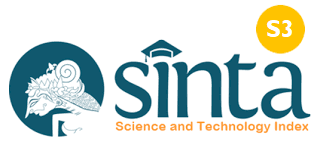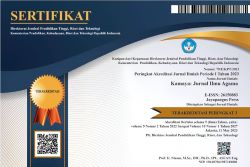Ajaran Tattwa Dalam Tutur Medang Kemulan
DOI:
https://doi.org/10.37329/kamaya.v6i4.2730Keywords:
Medang Kemulan, tattwaAbstract
Medang Kemulan's speech is one of the many speeches containing the teachings of Shiva. Judging from the language used and the sloka texts contained in it, it appears that the Medang Kemulan lontar is an old lontar. Tutur Medang Kemulan not only teaches about the teachings of wariga (kala or time) but also emphasizes the teachings of philosophy (Tattwa), namely ethics and human philosophy applied in community life. Tutur Medang Kemulan also teaches about regulating social institutions, especially Balinese society, which is widely discussed. Apart from being an understanding of the prohibition of incestuous marriage, Tutur Medang Kemulan also contains Hindu religious teachings, the aim of which is to realize human social life with individuals who are virtuous in accordance with the teachings of religious literature. Apart from that, in Tutur Medang Kemulan the teachings of self-control regarding human life are taught, namely a person's ability not to do things that are not good or appropriate. In general, this research aims to find out and understand the philosophical teachings (Tattwa) and time (kala) contained in the Medang Kemulan Tutur so that it can be used as a guide by Hindus and the wider community and motivated to understand more deeply the concept of life as a human contained in the Medang Tutur Glory. This type of research is qualitative research. The data source used is primary data sourced from literature/libraries. Data collection techniques were carried out using library methods. This research uses data analysis methods with qualitative descriptive techniques. The concept of Tattwa teachings is about the essence, truth and philosophy of life contained in Tutur Medang Kemulan, such as the concepts of social institutions, ethics, self-control and love.
References
Adiputra, I.G, R, dkk. (1990). Tattwa Darsana. Jakarta: Yayasan Dharma Sharati.
Adnyana, I. W. A. (2020). Nilai Pendidikan Tattwa Pada Tutur Parakriya. Jurnal Penelitian Agama Hindu, 4(1), 14-23.
Couteau, J. (2016). Memaknai Watugunung dan Oedipus Sang Raja sebagai Mitos tentang Waktu Yang Melampaui Waktu. Jurnal FIlsafat, 20(1), 27-43.
Febriadiana, D., Puspawati, L. P., & Putra, I. B. R. (2018). Teks Satua Betara Watugunung Dalam Cerita Rakyat Daerah Bali: Analisis Struktur dan Fungsi. Jurnal Humanis, 22(2), 342-353.
Laksono, A. T. (2022). Memahami Hakikat Cinta Pada Hubungan Manusia: Berdasarkan Perbandingan Sudut Pandang Filsafat Cinta Dan Psikologi Robert Sternberg. Jurnal Aqidah dan Filsafat Islam, 7(1).
Rahmatullah, A. S. (2021). Pendidikan Cinta Kasih Anak dalam Perspektif Filsafat Ilmu. Jurnal Filsafat Indonesia, 4(1), 72-77.
Ruhimat, M. (2017). Perbandingan Teks Cerita Aji Saka dalam Tradisi Tulis Masyarakat Sunda. Metahumaniora, 7(1), 91-99.
Oktaviani, N. P. S., & Sukmantara, N. (2020). Konsep Cinta Menurut Mahatma Gandhi. Vidya Darsan: Jurnal Mahasiswa Filsafat Hindu, 1(1), 41-53.
Sastrosupomo, S. (1983). Etika Sebuah Pengantar. Bandung: Offset Alumni.
Suadnyana, I. B. P. E. (2018). Nilai yang Terkandung dalam Gaguritan Mituturin Angga. Sanjiwani: Jurnal Filsafat, 9(2), 165-178.
Sura, & Yasa., S. (2009). Samkya dan Yoga. Denpasar: Lembaga Penenlitian Universitas Hindu Indonesia
Paramitha, N. M. A. S. P. (2021). Kajian Intertekstual Mitos Watugunung Dan Legenda Sangkuriang. Ganaya: Jurnal Ilmu Sosial dan Humaniora, 4(2), 890-905.
Paramitha, N. M. A. S. P. (2018). Theological Symbolisation Of Watugunung Myth And Sangkuriang Legend (Comparative Literature Study). Vidyottama Sanatana: International Journal of Hindu Science and Religious Studies, 2(2), 211-217.
Penyusun, T. (1991). Kamus Bali-Indonesia. Dinas Kebudayaan Prov. Bali.
Penyusun, T. (2001). Alih Aksara Dan terjemahan Tutur Bhuwana Mareka, Tutur Brahmokta Widhisatra dan Tutur Medang Kemulan. Dinas Kebudayaan Prov. Bali.
Pitriani, N. R. V. (2020). Tattwa dalam Yadnya Perspektif Filsafat Hindu (Siwa Tattwa) bagi Masyarakat Hindu di Bali. ŚRUTI: Jurnal Agama Hindu, 1(1), 45-57.
Purwaningsih, S. (2020). Pranata Sosial dalam Kehidupan Masyarakat. Alprin.
Wirawan, I. W. A., Suardiana, I. W., & Sutama, P. (2017) Tutur Medang Kemulan: Analisis Struktur dan Fungsi. Jurnal Humanis, Fakultas Ilmu Budaya Unud. Vol 18.2.
Wiratmaja, A. (1975). Etika Hindu Buku Kesatu.
Zulfah, Z. (2021). Karakter: Pengendalian Diri. Iqra: Jurnal Magister Pendidikan Islam, 1(1), 28-33.
Downloads
Published
How to Cite
Issue
Section
License
Copyright (c) 2023 Kamaya: Jurnal Ilmu Agama

This work is licensed under a Creative Commons Attribution-ShareAlike 4.0 International License.
An author who publishes in the Kamaya : Jurnal Ilmu Agama agrees to the following terms:
- Author retains the copyright and grants the journal the right of first publication of the work simultaneously licensed under the Creative Commons Attribution-ShareAlike 4.0 License that allows others to share the work with an acknowledgement of the work's authorship and initial publication in this journal
- Author is able to enter into separate, additional contractual arrangements for the non-exclusive distribution of the journal's published version of the work (e.g., post it to an institutional repository or publish it in a book) with the acknowledgement of its initial publication in this journal.
- Author is permitted and encouraged to post his/her work online (e.g., in institutional repositories or on their website) prior to and during the submission process, as it can lead to productive exchanges, as well as earlier and greater citation of the published work (See The Effect of Open Access).
Read more about the Creative Commons Attribution-ShareAlike 4.0 Licence here: https://creativecommons.org/licenses/by-sa/4.0/.





